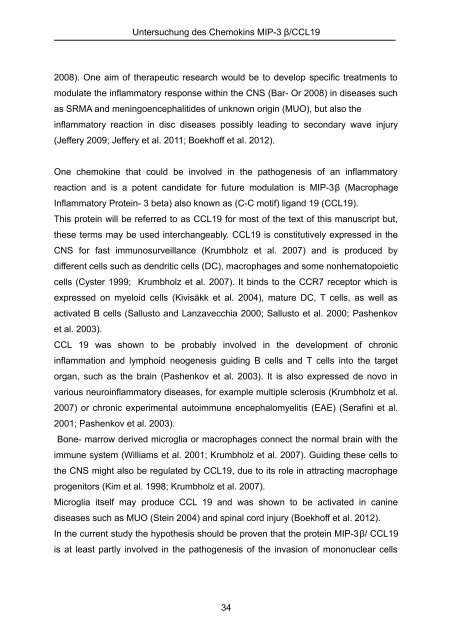TiHo Bibliothek elib - Tierärztliche Hochschule Hannover
TiHo Bibliothek elib - Tierärztliche Hochschule Hannover
TiHo Bibliothek elib - Tierärztliche Hochschule Hannover
You also want an ePaper? Increase the reach of your titles
YUMPU automatically turns print PDFs into web optimized ePapers that Google loves.
Untersuchung des Chemokins MIP-3 β/CCL19<br />
2008). One aim of therapeutic research would be to develop specific treatments to<br />
modulate the inflammatory response within the CNS (Bar- Or 2008) in diseases such<br />
as SRMA and meningoencephalitides of unknown origin (MUO), but also the<br />
inflammatory reaction in disc diseases possibly leading to secondary wave injury<br />
(Jeffery 2009; Jeffery et al. 2011; Boekhoff et al. 2012).<br />
One chemokine that could be involved in the pathogenesis of an inflammatory<br />
reaction and is a potent candidate for future modulation is MIP-3β (Macrophage<br />
Inflammatory Protein- 3 beta) also known as (C-C motif) ligand 19 (CCL19).<br />
This protein will be referred to as CCL19 for most of the text of this manuscript but,<br />
these terms may be used interchangeably. CCL19 is constitutively expressed in the<br />
CNS for fast immunosurveillance (Krumbholz et al. 2007) and is produced by<br />
different cells such as dendritic cells (DC), macrophages and some nonhematopoietic<br />
cells (Cyster 1999; Krumbholz et al. 2007). It binds to the CCR7 receptor which is<br />
expressed on myeloid cells (Kivisäkk et al. 2004), mature DC, T cells, as well as<br />
activated B cells (Sallusto and Lanzavecchia 2000; Sallusto et al. 2000; Pashenkov<br />
et al. 2003).<br />
CCL 19 was shown to be probably involved in the development of chronic<br />
inflammation and lymphoid neogenesis guiding B cells and T cells into the target<br />
organ, such as the brain (Pashenkov et al. 2003). It is also expressed de novo in<br />
various neuroinflammatory diseases, for example multiple sclerosis (Krumbholz et al.<br />
2007) or chronic experimental autoimmune encephalomyelitis (EAE) (Serafini et al.<br />
2001; Pashenkov et al. 2003).<br />
Bone- marrow derived microglia or macrophages connect the normal brain with the<br />
immune system (Williams et al. 2001; Krumbholz et al. 2007). Guiding these cells to<br />
the CNS might also be regulated by CCL19, due to its role in attracting macrophage<br />
progenitors (Kim et al. 1998; Krumbholz et al. 2007).<br />
Microglia itself may produce CCL 19 and was shown to be activated in canine<br />
diseases such as MUO (Stein 2004) and spinal cord injury (Boekhoff et al. 2012).<br />
In the current study the hypothesis should be proven that the protein MIP-3β/ CCL19<br />
is at least partly involved in the pathogenesis of the invasion of mononuclear cells<br />
34










![Tmnsudation.] - TiHo Bibliothek elib](https://img.yumpu.com/23369022/1/174x260/tmnsudation-tiho-bibliothek-elib.jpg?quality=85)





